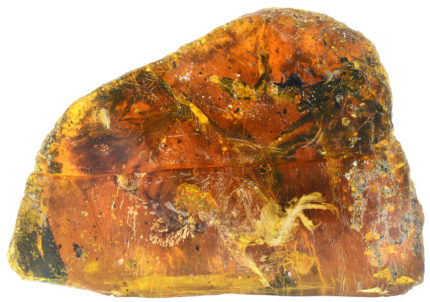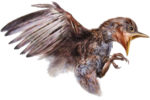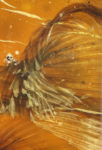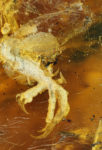
Researchers have discovered the remains of a baby avian dinosaur in a 99-million-year-old piece of Burmese amber. This is the most complete bird ever found trapped in amber, and it’s the most complete fossil of any kind found in Burmese amber. Its resinous coffin has preserved almost all of the skull and neck, a large section of one wing, one leg with perfect little claws and the soft tissues of the tail. Because so much of the bird has survived — almost half of it — researchers were able to identify it from its proportions and morphological features as a fledgling enantiornithes.
 Enantiornitheans were a clade of toothed avialan dinosaurs that went extinct about 65 million years ago, at the tail end of the Late Cretaceous period and dawn of the Paleogene, one of the 75% of terrestrial organisms obliterated in the Cretaceous–Paleogene extinction event. Fossils from 80 different species of enantiornitheans have been identified in every continent except Antarctica. Their diversity and wide geographical distribution indicates that at least of them were able to fly across oceans on their own wing power, the first bird-like animals to develop that ability.
Enantiornitheans were a clade of toothed avialan dinosaurs that went extinct about 65 million years ago, at the tail end of the Late Cretaceous period and dawn of the Paleogene, one of the 75% of terrestrial organisms obliterated in the Cretaceous–Paleogene extinction event. Fossils from 80 different species of enantiornitheans have been identified in every continent except Antarctica. Their diversity and wide geographical distribution indicates that at least of them were able to fly across oceans on their own wing power, the first bird-like animals to develop that ability.
Juvenile enantiornithes remains have been found in Burmese amber before, but they were just individual wings. Even from such small pieces, scientists were able to determine that enantiornitheans’ feathers shared the features of modern bird feathers, unlike other than flying dinosaurs like Archaeopteryx. This exceptional specimen provides researchers access to biology they’ve never seen before. The amount of surviving soft tissue gives them the opportunity to examine the opening of the ear, the eyelid and the scales.
In this specimen, scientists observed that while the baby enantiornithine already possessed a full set of flight feathers on its wings, the rest of the plumage was sparse and more similar to the theropod dinosaur feathers, which lack a well-defined central shaft, or rachis.
The presence of flight feathers on such a young bird is reinforcing the idea that enantiornithes hatched with the ability to fly, making them less dependent on parental care than most modern birds.
This independence came at a cost, however. The researchers point out that a slow growth rate made these ancient birds more vulnerable for a longer amount of time, as evidenced by the high number of juvenile enantiornithes found in the fossil record. (No juvenile fossil remains from any other bird lineage are known from the Cretaceous).
 The amber chunk (3.4 x 1.2 x 2.2 inches) containing this exceptional specimen of enantiornithes was mined at the Angbamo site in the Hukawng Valley of northern Myanmar, an incredibly rich source of amber deposits from the Cretaceous period (145.5 to 65.5 million years ago). Amber mined in Myanmar is believed to contain the greatest amount and diversity of Cretaceous animal and plant specimens. The large size and clarity of Burmese amber make the trapped remains invaluable sources for scientific study.
The amber chunk (3.4 x 1.2 x 2.2 inches) containing this exceptional specimen of enantiornithes was mined at the Angbamo site in the Hukawng Valley of northern Myanmar, an incredibly rich source of amber deposits from the Cretaceous period (145.5 to 65.5 million years ago). Amber mined in Myanmar is believed to contain the greatest amount and diversity of Cretaceous animal and plant specimens. The large size and clarity of Burmese amber make the trapped remains invaluable sources for scientific study.
 When the miners came across the enantiornithes preserved in amber, they thought it was some sort of weird lizard foot because of the prominent clawed hindfoot. Guang Chen, director of the Hupoge Amber Museum in Tengchong City, China, heard about the “lizard claw” in 2014 and acquired the sample. Chen alerted Lida Xing of the China University of Geosciences, whose team had studied a previous find of a therapod tail trapped in Burmese amber, to the specimen. Xing and her colleagues identified it as the hindlimb of an enantiornithes, not an odd lizard claw.
When the miners came across the enantiornithes preserved in amber, they thought it was some sort of weird lizard foot because of the prominent clawed hindfoot. Guang Chen, director of the Hupoge Amber Museum in Tengchong City, China, heard about the “lizard claw” in 2014 and acquired the sample. Chen alerted Lida Xing of the China University of Geosciences, whose team had studied a previous find of a therapod tail trapped in Burmese amber, to the specimen. Xing and her colleagues identified it as the hindlimb of an enantiornithes, not an odd lizard claw.
Technology then helped reveal there was so much more to this little guy than just his foot.
“[I thought we had] just a pair of feet and some feathers before it underwent CT imaging. It was a big, big, big surprise after that,” says Xing.
“The surprise continued when we started examining the distribution of feathers and realized that there were translucent sheets of skin that connected many of the body regions appearing in the CT scan data,” adds team co-leader Ryan McKellar of the Royal Saskatchewan Museum.
The amber specimen, named Belone after the Burmese word for the Oriental skylark which is amber in color, is now on display at the Hupoge Amber Museum. Between June 24th and the end of July, it will be on display at the Shanghai Museum of Natural History.
Lida Xing and her team have published the first paper on the specimen in the journal Gondwana Research. You can read it free of charge here.
“U-Pb dating of zircons from the volcaniclastic matrix of the amber gives a refined age estimate of approximately 98.8 ± 0.6 million years for the deposit.”
I never argue with U-Pb datings. 🙂
Poor little ‘Anti-fledgling’ (Enanti-) 🙁 – Looks as one of his first kiting attempts ended up in a blob of raisin.
I learned, however, that “enantiornithes” and “ornithes” differ in their shoulder anatomy, while “reptiles” and “ornithes” differ in their pelvic anatomy.
Is that more or less the case ?
Gosh, s/raisin/resin/g :facepalm: ..Moreover, I forgot to mention that in case there are any differences between ‘anti-birds‘ and ‘sheep‘, THIS will -without doubt- make them clear.
I cannot believe that this is the first almost complete bird from the dinosaurs. Although I believe we have come to the conclusion that the birds are so similar to what they were so long ago.
Am I the only one that’s sad for this bird? How scared he must have been 😥
I think I have one with 3 birds and eggs trapped in pine sap.
I think I have 3 birds and eggs trapped in pine sap.
I think I have 3 birds and eggs trapped in pine :p